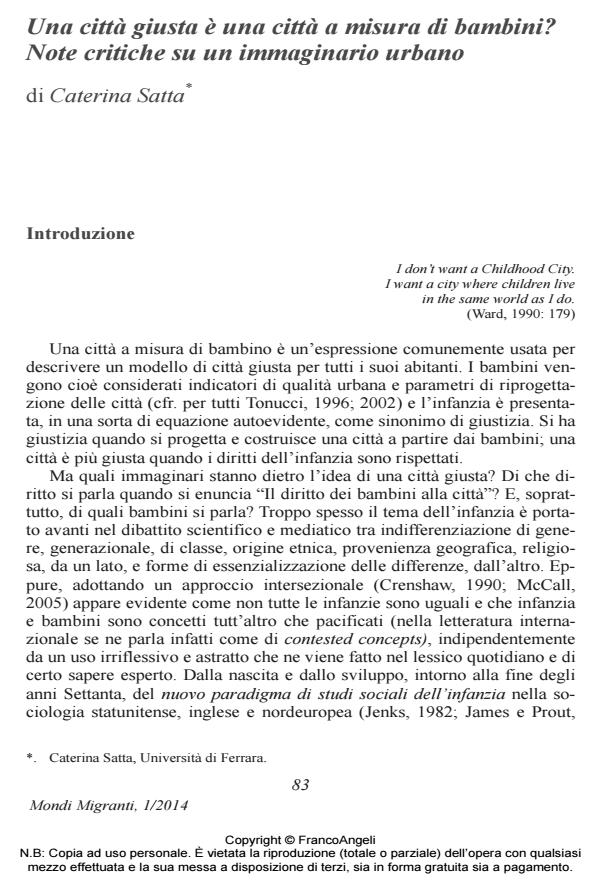Is a just city a child-friendly city? Critical notes on an urban imaginary
Journal title MONDI MIGRANTI
Author/s Caterina Satta
Publishing Year 2014 Issue 2014/1
Language Italian Pages 17 P. 83-99 File size 149 KB
DOI 10.3280/MM2014-001006
DOI is like a bar code for intellectual property: to have more infomation
click here
Below, you can see the article first page
If you want to buy this article in PDF format, you can do it, following the instructions to buy download credits

FrancoAngeli is member of Publishers International Linking Association, Inc (PILA), a not-for-profit association which run the CrossRef service enabling links to and from online scholarly content.
A child-friendly city is an expression commonly employed when describing the model of a city which is just for all of its inhabitants. In this discourse, children are valued as indicators of the quality of life in urban environments and as parameters for city re-planning; moreover, in a sort of self-evident equation, childhood is taken as a synonym of justice. Justice is respected, therefore, when a city is planned and built from the point of view of its children; a city is more just when children’s rights are taken seriously. But on what imaginaries does this idea(l) of a just city rest? What kind of right is the "children’s right to the city?" And, above all, which children are we considering? The present article, written from the perspective of the new sociology of childhood, investigates the concept of spatial justice as an interpretive tool for the recognition and understanding of children’s specific experience within urban space.
Keywords: Children, differences, imaginaries, urban space, play, spatial justice
- Capabilities, Learning, and Urban Quality of Life Arianna Luisa Cavaliere, pp.9 (ISBN:978-3-658-49430-8)
- Children’s Spatialities Caterina Satta, pp.178 (ISBN:978-1-137-46497-2)
- Cohousing in Italy Manuela Maggio, pp.91 (ISBN:978-3-031-83276-5)
- Capabilities, Learning, and Urban Quality of Life Arianna Luisa Cavaliere, pp.161 (ISBN:978-3-658-49430-8)
- Ri-pubblicizzare la città: pratiche spaziali, culture e istituzioni Adriano Cancellieri, Elena Ostanel, in TERRITORIO 68/2014 pp.46
DOI: 10.3280/TR2014-068007 - Sport and public space in contemporary Italian cities: processes of citizenship construction through body-related practices Caterina Satta, Giuseppe Scandurra, in Modern Italy /2015 pp.229
DOI: 10.1080/13532944.2015.1072966 - Sport and public space in contemporary Italian cities: processes of citizenship construction through body-related practices Caterina Satta, Giuseppe Scandurra, in Modern Italy /2015 pp.229
DOI: 10.1080/13532944.2015.1072966
Caterina Satta, Una città giusta è una città a misura di bambini? Note critiche su un immaginario urbano in "MONDI MIGRANTI" 1/2014, pp 83-99, DOI: 10.3280/MM2014-001006